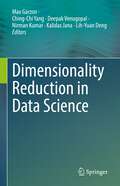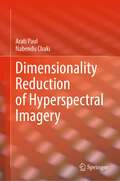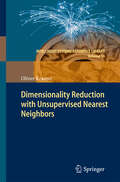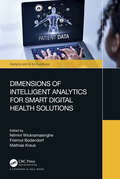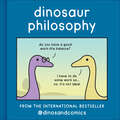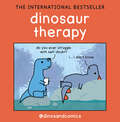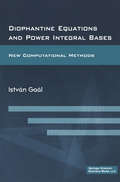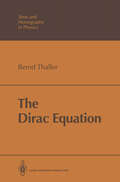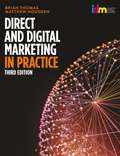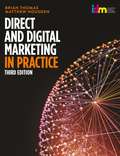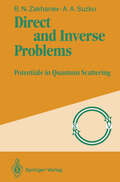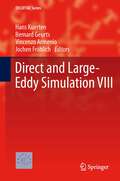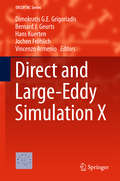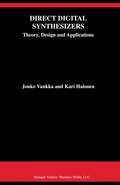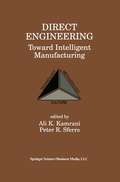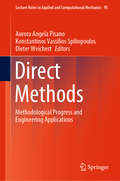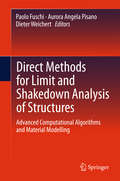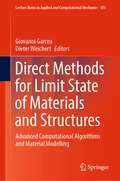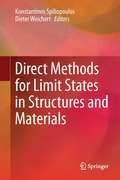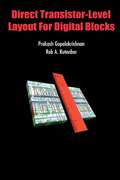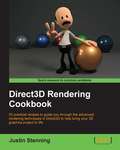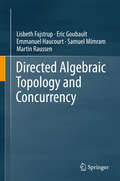- Table View
- List View
Dimensionality Reduction in Data Science
by Max Garzon Ching-Chi Yang Deepak Venugopal Nirman Kumar Kalidas Jana Lih-Yuan DengThis book provides a practical and fairly comprehensive review of Data Science through the lens of dimensionality reduction, as well as hands-on techniques to tackle problems with data collected in the real world. State-of-the-art results and solutions from statistics, computer science and mathematics are explained from the point of view of a practitioner in any domain science, such as biology, cyber security, chemistry, sports science and many others. Quantitative and qualitative assessment methods are described to implement and validate the solutions back in the real world where the problems originated.The ability to generate, gather and store volumes of data in the order of tera- and exo bytes daily has far outpaced our ability to derive useful information with available computational resources for many domains.This book focuses on data science and problem definition, data cleansing, feature selection and extraction, statistical, geometric, information-theoretic, biomolecular and machine learning methods for dimensionality reduction of big datasets and problem solving, as well as a comparative assessment of solutions in a real-world setting.This book targets professionals working within related fields with an undergraduate degree in any science area, particularly quantitative. Readers should be able to follow examples in this book that introduce each method or technique. These motivating examples are followed by precise definitions of the technical concepts required and presentation of the results in general situations. These concepts require a degree of abstraction that can be followed by re-interpreting concepts like in the original example(s). Finally, each section closes with solutions to the original problem(s) afforded by these techniques, perhaps in various ways to compare and contrast dis/advantages to other solutions.
Dimensionality Reduction of Hyperspectral Imagery
by Arati Paul Nabendu ChakiThis book provides information about different types of dimensionality reduction (DR) methods and their effectiveness in hyperspectral data processing. The authors first explain how hyperspectral imagery (HSI) plays an important role in remote sensing due to its high spectral resolution that enables better identification of different materials on the earth’s surface. The authors go on to describe potential challenges due to HSI being acquired in hundreds of narrow and contiguous bands, represented as a 3-dimensional image cube, often causing the bands to contain information redundancy. They then show how processing a large number of bands adds challenges in terms of computation complexity that reduces efficiency. The authors then present how DR is an essential step in hyperspectral data analysis to solve these issues. Overall, the book helps readers understand the DR processes and its impact in effective HSI analysis.
Dimensionality Reduction with Unsupervised Nearest Neighbors (Intelligent Systems Reference Library #51)
by Oliver KramerThis book is devoted to a novel approach for dimensionality reduction based on the famous nearest neighbor method that is a powerful classification and regression approach. It starts with an introduction to machine learning concepts and a real-world application from the energy domain. Then, unsupervised nearest neighbors (UNN) is introduced as efficient iterative method for dimensionality reduction. Various UNN models are developed step by step, reaching from a simple iterative strategy for discrete latent spaces to a stochastic kernel-based algorithm for learning submanifolds with independent parameterizations. Extensions that allow the embedding of incomplete and noisy patterns are introduced. Various optimization approaches are compared, from evolutionary to swarm-based heuristics. Experimental comparisons to related methodologies taking into account artificial test data sets and also real-world data demonstrate the behavior of UNN in practical scenarios. The book contains numerous color figures to illustrate the introduced concepts and to highlight the experimental results.
Dimensions of Intelligent Analytics for Smart Digital Health Solutions (Analytics and AI for Healthcare)
by Nilmini Wickramasinghe Freimut Bodendorf Mathias KrausThis title demystifies artificial intelligence (AI) and analytics, upskilling individuals (healthcare professionals, hospital managers, consultants, researchers, students, and the population at large) around analytics and AI as it applies to healthcare. This book shows how the tools, techniques, technologies, and tactics around analytics and AI can be best leveraged and utilised to realise a healthcare value proposition of better quality, better access and high value for everyone every day, everywhere. The book presents a triumvirate approach including technical, business and medical aspects of data and analytics and by so doing takes a responsible approach to this key area. This work serves to introduce the critical issues in AI and analytics for healthcare to students, practitioners, and researchers.
Dimensions of Intelligent Analytics for Smart Digital Health Solutions (Analytics and AI for Healthcare)
This title demystifies artificial intelligence (AI) and analytics, upskilling individuals (healthcare professionals, hospital managers, consultants, researchers, students, and the population at large) around analytics and AI as it applies to healthcare. This book shows how the tools, techniques, technologies, and tactics around analytics and AI can be best leveraged and utilised to realise a healthcare value proposition of better quality, better access and high value for everyone every day, everywhere. The book presents a triumvirate approach including technical, business and medical aspects of data and analytics and by so doing takes a responsible approach to this key area. This work serves to introduce the critical issues in AI and analytics for healthcare to students, practitioners, and researchers.
Dinosaur Therapy
by James Stewarta comic about dinosaurs navigating the complexities of life, together
Diophantine Equations and Power Integral Bases: New Computational Methods
by Istvan GaalWork examines the latest algorithms and tools to solve classical types of diophantine equations.; Unique book---closest competitor, Smart, Cambridge, does not treat index form equations.; Author is a leading researcher in the field of computational algebraic number theory.; The text is illustrated with several tables of various number fields, including their data on power integral bases.; Several interesting properties of number fields are examined.; Some infinite parametric families of fields are also considered as well as the resolution of the corresponding infinite parametric families of diophantine equations.
The Dirac Equation (Theoretical and Mathematical Physics)
by Bernd ThallerEver since its invention in 1929 the Dirac equation has played a fundamental role in various areas of modern physics and mathematics. Its applications are so widespread that a description of all aspects cannot be done with sufficient depth within a single volume. In this book the emphasis is on the role of the Dirac equation in the relativistic quantum mechanics of spin-1/2 particles. We cover the range from the description of a single free particle to the external field problem in quantum electrodynamics. Relativistic quantum mechanics is the historical origin of the Dirac equation and has become a fixed part of the education of theoretical physicists. There are some famous textbooks covering this area. Since the appearance of these standard texts many books (both physical and mathematical) on the non relativistic Schrodinger equation have been published, but only very few on the Dirac equation. I wrote this book because I felt that a modern, comprehensive presentation of Dirac's electron theory satisfying some basic requirements of mathematical rigor was still missing.
Direct and Digital Marketing in Practice
by Brian Thomas Matthew HousdenDirect and Digital Marketing in Practice is the essential manual for all managers, marketers and students. Incisive and thorough, the text has been fully updated to reflect the continuing impact and future implications of the Internet on marketing. This new 3rd edition is one of the only comprehensive textbooks written entirely by current practising professionals. It explains in detail the powerful offline and online techniques available to direct marketers today. Direct and Digital Marketing in Practice covers vital issues such as: · the new marketing landscape; · gaining customer insight; · maximising returns on marketing investment;· integrating traditional and digital media; · campaign planning and budgeting;· offline and online metrics:· testing and statistics; and· developing compelling propositions.Direct and Digital Marketing in Practice is an ideal reference tool, presenting detailed explanations of key concepts with practical examples and case studies. The book ensures that each point is relevant and memorable, and made in a real-world context. Written for managers looking to expand and enhance customer reach, students on MBA courses, and those taking professional qualifications, the book provides an invaluable and up-to-date guide to marketing best theory and practice in our increasingly digital and online age.
Direct and Digital Marketing in Practice (PDF)
by Brian Thomas Matthew HousdenDirect and Digital Marketing in Practice is the essential manual for all managers, marketers and students. Incisive and thorough, the text has been fully updated to reflect the continuing impact and future implications of the Internet on marketing. This new 3rd edition is one of the only comprehensive textbooks written entirely by current practising professionals. It explains in detail the powerful offline and online techniques available to direct marketers today. Direct and Digital Marketing in Practice covers vital issues such as: · the new marketing landscape; · gaining customer insight; · maximising returns on marketing investment;· integrating traditional and digital media; · campaign planning and budgeting;· offline and online metrics:· testing and statistics; and· developing compelling propositions.Direct and Digital Marketing in Practice is an ideal reference tool, presenting detailed explanations of key concepts with practical examples and case studies. The book ensures that each point is relevant and memorable, and made in a real-world context. Written for managers looking to expand and enhance customer reach, students on MBA courses, and those taking professional qualifications, the book provides an invaluable and up-to-date guide to marketing best theory and practice in our increasingly digital and online age.
Direct and Inverse Problems: Potentials in Quantum Scattering
by Boris N. Zakhariev Allina A. SuzkoRapid progress in quantum theory brings us new important results which are often not immediately clear to all who need them. But fortunately, this is also followed by simplifications and unifications of our previous concepts. The inverse problem method ("The most beautiful idea of the XX-th century" - Zakharov et aI., 1980) has just both these aspects. It is rather astonishing that it took 50 years after the foundation of quantum mechanics for the creation of the "pictures" showing the direct connection of obser vables with interactions. Recently, illustrations of this type began to appear in the literature (e. g., how potentials are deformed with thc shift of one energy level or change of some resonance reduced width). Although they are transparent to those studying the quantum world and can be included within the necessary elements of quantum literacy, they are still largely unknown even to many specialists. For the first time, the most interesting of these pictures enriching our quantum intuition are col lected here and placed at your disposal. The readers of this monograph have the advantage of getting the latest information which became available after the publication of the Russian edition. It has been incor porated here in the simplest presentation possible. For example, new sections con cerning exactly solvable models, including the multi-channel, multi-dimensional ones and with time dependent potentials have been added. The first attempts in solving the three-body inverse problem are also mentioned.
Direct and Large-Eddy Simulation VIII (ERCOFTAC Series #15)
by Bernard Geurts Vincenzo Armenio Jochen Öhlich Hans KuertenThis volume continues previous DLES proceedings books, presenting modern developments in turbulent flow research. It is comprehensive in its coverage of numerical and modeling techniques for fluid mechanics.After Surrey in 1994, Grenoble in 1996, Cambridge in 1999, Enschede in 2001, Munich in 2003, Poitiers in 2005, and Trieste in 2009, the 8th workshop, DLES8, was held in Eindhoven, The Netherlands, again under the auspices of ERCOFTAC. Following the spirit of the series, the goal of this workshop is to establish a state-of-the-art of DNS and LES techniques for the computation and modeling of transitional/turbulent flows covering a broad scope of topics such as aerodynamics, acoustics, combustion, multiphase flows, environment, geophysics and bio-medical applications. This gathering of specialists in the field was a unique opportunity for discussions about the more recent advances in the prediction, understanding and control of turbulent flows in academic or industrial situations.
Direct and Large-Eddy Simulation X (ERCOFTAC Series #24)
by Dimokratis G.E. Grigoriadis Bernard J. Geurts Hans Kuerten Jochen Fröhlich Vincenzo ArmenioThis book addresses nearly all aspects of the state of the art in LES & DNS of turbulent flows, ranging from flows in biological systems and the environment to external aerodynamics, domestic and centralized energy production, combustion, propulsion as well as applications of industrial interest. Following the advances in increased computational power and efficiency, several contributions are devoted to LES & DNS of challenging applications, mainly in the area of turbomachinery, including flame modeling, combustion processes and aeroacoustics.The book includes work presented at the tenth Workshop on 'Direct and Large-Eddy Simulation' (DLES-10), which was hosted in Cyprus by the University of Cyprus, from May 27 to 29, 2015. The goal of the workshop was to establish a state of the art in DNS, LES and related techniques for the computation and modeling of turbulent and transitional flows. The book is of interest to scientists and engineers, both in the early stages of their career and at a more senior level.
Direct Digital Synthesizers: Theory, Design and Applications (The Springer International Series in Engineering and Computer Science #614)
by Jouko Vankka Kari A.I. HalonenA major advantage of a direct digital synthesizer is that its output frequency, phase and amplitude can be precisely and rapidly manipulated under digital processor control. This book was written to find possible applications for radio communication systems.
Direct Engineering: Toward Intelligent Manufacturing
by Ali K. Kamrani Peter R. SferroDirect Engineering (DE) is the creation of a product development cycle into a single, unified process. The design process in most industries is an evolutionary one (i.e., incremental changes to some existing design). DE is a manufacturing process that seeks to improve the design processes by providing complete archival documentation of existing designs. It uses three-dimensional geometric models with integrated manufacturing information throughout the design process. DE reduces the design cycle, and the variety and number of engineering changes. This process decreases the design cycle time, increases productivity, and provides a higher quality product. The required technologies and methodologies that will support the development of the DE environment are: (1) product representation using feature-based modeling; (2) knowledge-based applications that will support the entire product development cycle; (3) an engineering environment implemented around distributed computing and object-oriented systems; (4) direct manufacturing techniques using rapid prototyping. Direct Engineering: Toward Intelligent Manufacturing addresses the following recent topics related to the development, implementation, and integration of the DE environment: (1) the current scope of the research in intelligent manufacturing; (2) the results of the technologies and tools developed for integrated product and process designs, and (3) examination of the methodologies and algorithms used for the implementation of direct engineering.
Direct, Indirect and Index Register Addressing (tactile)
by RnibThis diagram shows 3 diagrams over 3 pages showing direct, indirect and index register addressing. Page 1 shows direct addressing and shows an arrow from a box labelled operand to data within a box labelled memory. Page 2 show indirect addressing an arrow moving from the operand to an address and then to data within the memory. Page 3 shows lines moving from boxes labelled operand and index register to a circle labelled +. Then moving onto data within the memory.
Direct Methods: Methodological Progress and Engineering Applications (Lecture Notes in Applied and Computational Mechanics #95)
by Aurora Angela Pisano Konstantinos Vassilios Spiliopoulos Dieter WeichertThis book provides an overview of direct methods such as limit and shakedown analysis, which are intended to do away with the need for cumbersome step-by-step calculations and determine the loading limits of mechanical structures under monotone, cyclic or variable loading with unknown loading history. The respective contributions demonstrate how tremendous advances in numerical methods, especially in optimization, have contributed to the success of direct methods and their practical applicability to engineering problems in structural mechanics, pavement and general soil mechanics, as well as the design of composite materials. The content reflects the outcomes of the workshop “Direct Methods: Methodological Progress and Engineering Applications,” which was offered as a mini-symposium of PCM-CMM 2019, held in Cracow, Poland in September 2019.
Direct Methods for Limit and Shakedown Analysis of Structures: Advanced Computational Algorithms and Material Modelling (Solid Mechanics and Its Applications #220)
by Paolo Fuschi Aurora Angela Pisano Dieter WeichertArticles in this book examine various materials and how to determine directly the limit state of a structure, in the sense of limit analysis and shakedown analysis. Apart from classical applications in mechanical and civil engineering contexts, the book reports on the emerging field of material design beyond the elastic limit, which has further industrial design and technological applications. Readers will discover that “Direct Methods” and the techniques presented here can in fact be used to numerically estimate the strength of structured materials such as composites or nano-materials, which represent fruitful fields of future applications.Leading researchers outline the latest computational tools and optimization techniques and explore the possibility of obtaining information on the limit state of a structure whose post-elastic loading path and constitutive behavior are not well defined or well known. Readers will discover how Direct Methods allow rapid and direct access to requested information in mathematically constructive manners without cumbersome step-by-step computation.Both researchers already interested or involved in the field and practical engineers who want to have a panorama of modern methods for structural safety assessment will find this book valuable. It provides the reader with the latest developments and a significant amount of references on the topic.
Direct Methods for Limit State of Materials and Structures: Advanced Computational Algorithms and Material Modelling (Lecture Notes in Applied and Computational Mechanics #101)
by Giovanni Garcea Dieter WeichertThis book provides an overview of direct methods, such as limit and shakedown analysis, which are intended for avoiding cumbersome step-by-step calculations to determine the limit states of mechanical structures under monotone, cyclic or variable actions with unknown loading history. The book comprises several contributions that demonstrate how tremendous advances in numerical methods, especially in optimization, have contributed to the success of direct methods and their applicability to practical engineering problems in structural mechanics and mechanics of materials. The contents reflect the outcomes of the workshop “Direct Methods for Limit State of Materials and Structures,” held in Cosenza, Italy in June 2022.
Direct Methods for Limit States in Structures and Materials
by Konstantinos Spiliopoulos Dieter WeichertKnowing the safety factor for limit states such as plastic collapse, low cycle fatigue or ratcheting is always a major design consideration for civil and mechanical engineering structures that are subjected to loads. Direct methods of limit or shakedown analysis that proceed to directly find the limit states offer a better alternative than exact time-stepping calculations as, on one hand, an exact loading history is scarcely known, and on the other they are much less time-consuming. This book presents the state of the art on various topics concerning these methods, such as theoretical advances in limit and shakedown analysis, the development of relevant algorithms and computational procedures, sophisticated modeling of inelastic material behavior like hardening, non-associated flow rules, material damage and fatigue, contact and friction, homogenization and composites.
Direct Transistor-Level Layout for Digital Blocks
by Prakash Gopalakrishnan Rob A. RutenbarCell-based design methodologies have dominated layout generation of digital circuits. Unfortunately, the growing demands for transparent process portability, increased performance, and low-level device sizing for timing/power are poorly handled in a fixed cell library. Direct Transistor-Level Layout For Digital Blocks proposes a direct transistor-level layout approach for small blocks of custom digital logic as an alternative that better accommodates demands for device-level flexibility. This approach captures essential shape-level optimizations, yet scales easily to netlists with thousands of devices, and incorporates timing optimization during layout. The key idea is early identification of essential diffusion-merged MOS device groups, and their preservation in an uncommitted geometric form until the very end of detailed placement. Roughly speaking, essential groups are extracted early from the transistor-level netlist, placed globally, optimized locally, and then finally committed each to a specific shape-level form while concurrently optimizing for both density and routability. The essential flaw in prior efforts is an over-reliance on geometric assumptions from large-scale cell-based layout algorithms. Individual transistors may seem simple, but they do not pack as gates do. Algorithms that ignore these shape-level issues suffer the consequences when thousands of devices are poorly packed. The approach described in this book can pack devices much more densely than a typical cell-based layout.Direct Transistor-Level Layout For Digital Blocks is a comprehensive reference work on device-level layout optimization, which will be valuable to CAD tool and circuit designers.
Direct3D Rendering Cookbook
by Justin StenningThis is a practical cookbook that dives into the various methods of programming graphics with a focus on games. It is a perfect package of all the innovative and up-to-date 3D rendering techniques supported by numerous illustrations, strong sample code, and concise explanations. Direct3D Rendering Cookbook is for C# .NET developers who want to learn the advanced rendering techniques made possible with DirectX 11.2. It is expected that the reader has at least a cursory knowledge of graphics programming, and although some knowledge of Direct3D 10+ is helpful, it is not necessary. An understanding of vector and matrix algebra is required.
Directed Algebraic Topology and Concurrency (SpringerBriefs in Applied Sciences and Technology)
by Lisbeth Fajstrup Eric Goubault Emmanuel Haucourt Samuel Mimram Martin RaussenThis monograph presents an application of concepts and methods from algebraic topology to models of concurrent processes in computer science and their analysis.Taking well-known discrete models for concurrent processes in resource management as a point of departure, the book goes on to refine combinatorial and topological models. In the process, it develops tools and invariants for the new discipline directed algebraic topology, which is driven by fundamental research interests as well as by applications, primarily in the static analysis of concurrent programs.The state space of a concurrent program is described as a higher-dimensional space, the topology of which encodes the essential properties of the system. In order to analyse all possible executions in the state space, more than “just” the topological properties have to be considered: Execution paths need to respect a partial order given by the time flow. As a result, tools and concepts from topology have to be extended to take privileged directions into account.The target audience for this book consists of graduate students, researchers and practitioners in the field, mathematicians and computer scientists alike.
